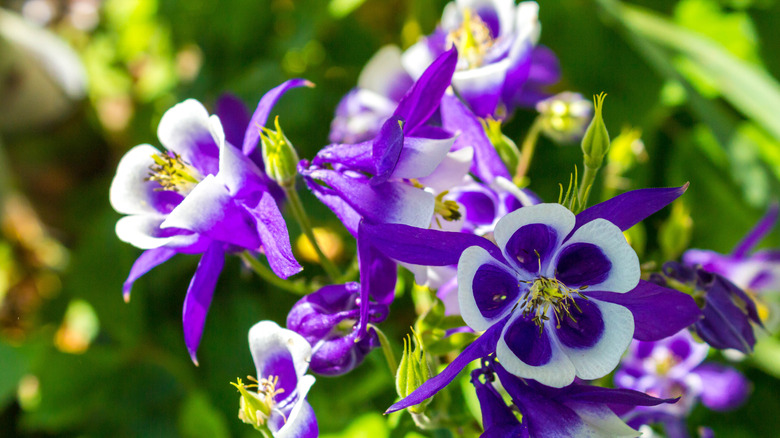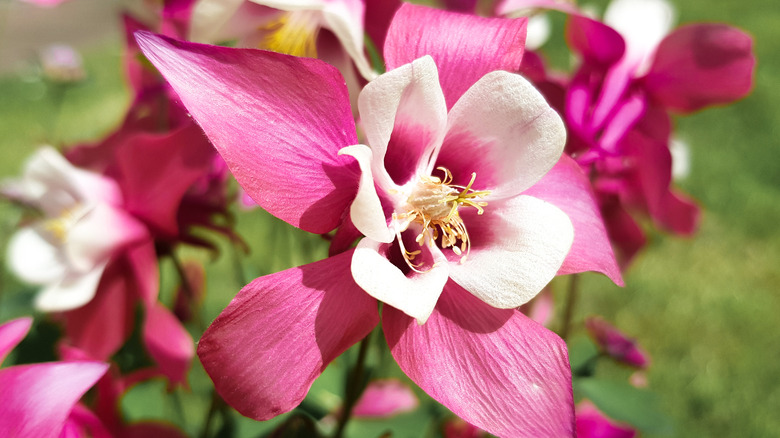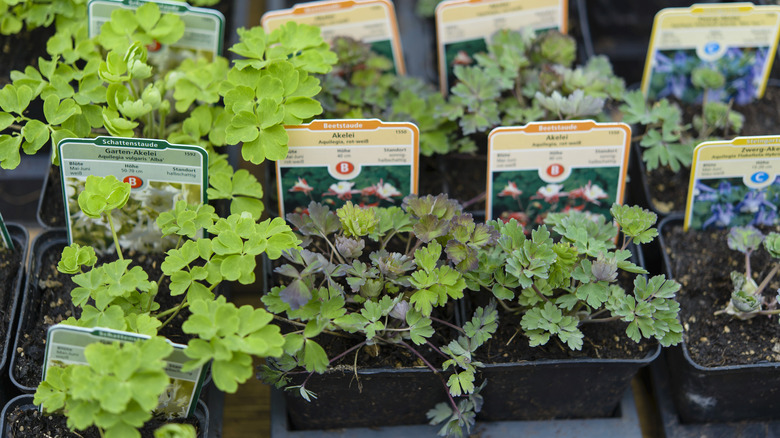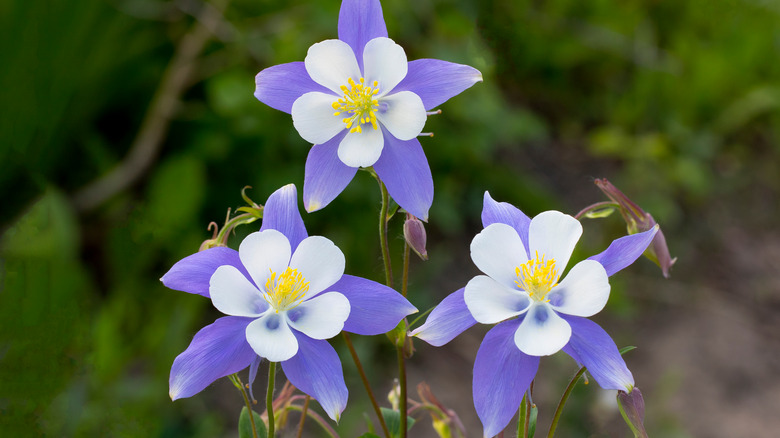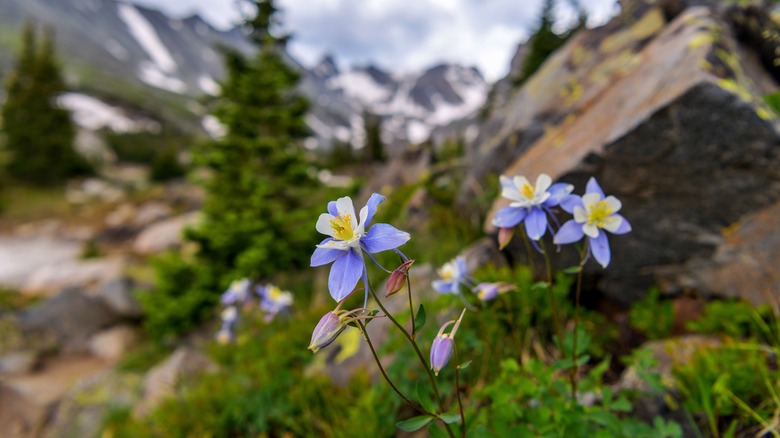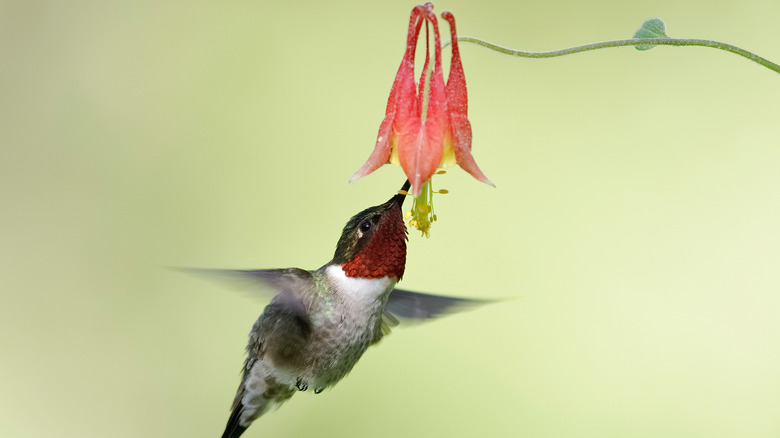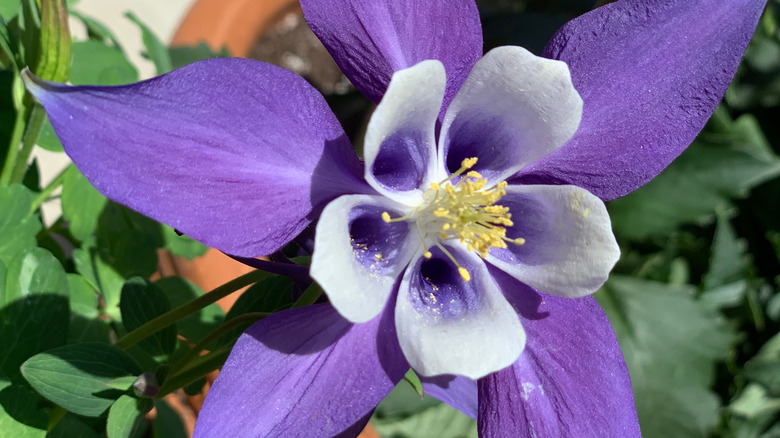How To Grow And Take Care Of Columbine Flower
Columbine flower (scientific name: Aquilegia) is a perennial flowering plant known for the unique appearance of its blooms, as per Almanac. The bloom consists of five evenly sized petals that cup the internal stamen while a second layer of longer, pointed petals shoot out from around the base. This second ring of petals gives the flower its scientific name, which comes from the word for eagle in Latin, due to the way its appearance mimics that of an eagle's talons, according to Petal Republic. However, the common name for this flower comes from an entirely different interpretation. Columbine can be traced back to the Latin word columba, for dove. Looking at the bloom upside down, viewers often see a circle of doves.
Each bloom often features two or more colors, including orange, pink, purple, white, and yellow, making them a popular feature in any garden (via Almanac). Planting columbine flowers in your yard will also ensure the arrival of birds and butterflies. This plant averages around 1 to 2 feet in height and 6 inches to 2 feet in width, according to Better Homes & Gardens. You can enjoy its blooms from late spring through the summer while the dark green-blue foliage will stay present year-round.
If you're ready to add columbine flower to your garden, you'll be pleased to know that it isn't hard to grow nor does it require much maintenance. Keep scrolling for a complete guide on how to grow and care for this plant.
How to use columbine flower in garden
Columbine flower is versatile and will match the aesthetic of many gardens, including cottage, woodland, and suburban. They are a great option for planting in beds and along borders, whether humanmade or natural, as per Houzz. When it comes to shorter varieties, try planting them in the front of beds to prevent them from disappearing in the mix of neighboring plants. Taller varieties work great planted along the back of beds or against the house and other barriers. If the space allows it, you can even plant them in large swaths to mimic the way they naturally grow in fields and woodlands. Make sure you think ahead to when the growing season is over as well — the foliage grows close to the ground, making it a fantastic option for planting among ornamental grasses and other low-growing evergreen plants.
Gardener's Path points out some of columbine flower's ideal companion plants, including heuchera, iris, peony, allium, daylily, and poppy. You can also take advantage of this plant's shade-tolerant nature by planting it among shrubs or taller plants. During the blooming season, the flowers will stand out against the green foliage that surrounds them. Lastly, columbines are a great candidate for pots and containers, allowing you to move them around throughout your garden and enjoy their colorful display on patios, decks, and balconies. Keep in mind that columbines likely won't do well as indoor plants.
How to grow columbine flower
You have a couple options for planting columbine flower in your garden — you can either purchase them as seeds or as pre-established plants from your local nursery, according to Burpee. When it comes to sowing columbines from seeds, you can either do so indoors or outdoors. If you choose to sow them outdoors, you will need to wait until the last threat of frost has passed in the spring. You will also need to chill them ahead of time in your refrigerator for about a month at a temperature of around 40 degrees Fahrenheit. When it comes time to plant them, choose a sunny area of your garden rich in organic soil. The next step is to place your seeds in the soil and leave them only lightly covered with it. Water regularly to ensure the soil doesn't dry out. In about a month, you can choose the strongest seedlings and remove the rest, leaving around 10 inches between each one.
To sow seeds indoors, you should purchase seed trays and a seed-starting soil mix. Start by refrigerating the seeds for around a month before taking them out and adding a bit of seed-starting formula. A month later, you will see the seedlings emerge from their trays. They will need plenty of sun and fluorescent lighting during the day to prepare them for transplant outdoors. Make sure to harden them off before planting them in your garden to reduce the risk of shock.
How to care for columbine flower
Columbine flower grows well in a wide range of regions and thrives specifically in USDA zones 3 through 9, as per The Spruce. With the right growing conditions, you'll find that this plant is relatively easy to care for. That being said, columbines are somewhat picky about sun exposure. They like partial shade during hot summer days but will need to receive extra sun during cooler days. Note that columbines won't tolerate extreme heat. They also prefer soil that is full of organic nutrients and layered with compost. The soil should drain well to prevent your columbines from succumbing to root rot and other fungal diseases. A neutral pH that leans acidic is also ideal.
Watering needs differ between young and well-established plants. While they are still maturing, columbines need extra water to facilitate growth. However, once mature, water should only be given once the first couple inches of soil is dry to the touch. Depending on the amount of rainfall your area receives, this averages out to about once a week. When the plant is actively growing flowers, you should provide it with a bit of phosphorous-rich fertilizer every four weeks to aid in health and development. The fertilizer should be low in nitrogen so as not to impair bloom growth. The last thing you'll need to pay attention to in order to ensure your columbines are happy and thriving is pruning. You should pinch off any dead blooms throughout the growing season.
Varieties of columbine flower
Columbine flower is also known by its scientific name, Aquilegia, and boasts 70 different species within the genus, as per Trees. This plant was originally discovered in North America; however, certain varieties can be traced back to Eastern Europe and Central Asia, according to the U.S. Forest Service. Experts believe that Aquilegia made its way to North America across the Bering land bridge between 10,000 and 40,000 years ago. The varieties of columbine have since evolved and can be differentiated based on geological region and appearance.
Among the many varieties of Aquilegia is the Rocky Mountain columbine, which hails from the mountainous region in the western United States, shares Better Homes & Gardens. This variety is marked by a layer of stunning purple petals and another ring of ivory-white petals. The yellow columbine is none other than bright yellow in hue and is native to the Rockies in New Mexico. The Canadian columbine features red and yellow flowers that droop perpetually on their stems. It is one of the larger varieties of columbine, growing up to 3 feet in height. You may also be interested in the Melba Higgins' columbine, another tall-growing variety that hits heights of around 2.5 feet when fully grown. Its blooms are a delicate periwinkle in color. For a shorter variety, try the Spring Magic Navy and White columbine, which grows to a mere foot when mature. What it may lack in height, it makes up for in bright, bold color.
Is columbine flower toxic?
In short, columbine flower is incredibly toxic to both humans and pets, according to Trees. It contains chemical properties that lead to digestive distress when ingested. Symptoms can include vomiting, diarrhea, and stomachaches. You should never consume any part of the plant, but should specifically stay away from the roots and seeds as these components contain the most toxicity. In addition to digestive issues, consumption can also lead to cardiovascular deterioration due to the presence of carcinogens and aconitum. It is recommended to wear gloves when handling the plant as well to avoid skin rashes from irritants found in the sap.
Despite the toxic nature of columbines, some varieties of this plant have a history of being used in medicine by Native American populations, as per Adirondacks Forever Wild. The seeds were used to treat headaches and other physical ailments, including bladder and kidney problems and fever. They were also incorporated into shampoos and perfumes. Crushed seeds were even believed to function as a love talisman when rubbed between the hands. Note that to be on the safe side, you should never attempt to reproduce these home remedies.
If you or someone in your family has accidentally ingested any part of a columbine flower, you should contact your nearest emergency medical facility or poison control center for immediate treatment. The same goes for pets — if you notice any toxicity symptoms, get in touch with a veterinary hospital or animal poison control line.
How to repot columbine flower
If you've decided to grow your columbines in pots, you should be aware that there may come a time when you need to upgrade the size of the container. In general, if your columbine is still maturing, it will need to be transplanted possibly more than once to a bigger container. Once fully grown, you shouldn't need to repot it. Food52 outlines a number of signs to keep an eye out for when your plant needs repotting. If you notice the roots growing out of the drainage holes, it's likely time for a new pot. Another indication is if the plant starts to look unwell, either ceasing to thrive or displaying yellowing and dying leaves. In this latter case, you will need to rule out other causes, such as over- or under-watering, before deciding to repot.
So you've determined that your columbine is ready for a bigger container. You should make sure the new pot is only one size larger than the current one. Gardening Channel also advises gardeners to choose a shallow pot for columbines. You should purchase a potting soil that is rich in organic material and fill the base of the new pot, leaving room for the root ball to sit comfortably on top without extending above the lip of the container. Once you've situated the columbine in the new container, fill in the rest with soil and add a bit of mulch at the top. Finally, water the plant generously.
